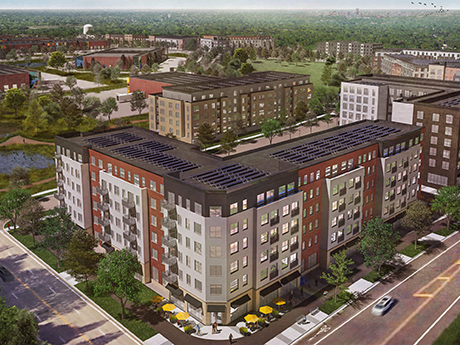By Chris Collins, Marcus & Millichap
The Minneapolis–St. Paul apartment market is currently experiencing a transformation, shaped by shifting economic conditions, changing demographics and evolving public policy. Having strong fundamentals in past multifamily housing development, the Twin Cities have entered a period of recalibration.
After years of record-breaking development numbers, the construction pipeline has slowed dramatically, while demand remains across the metro. Like many markets, the Twin Cities face affordability challenges, aging populations and regulatory uncertainty.

A major factor of the current market is the sharp decrease in new apartment construction. Following a peak in multifamily housing permits of more than 15,000 in 2022, the Twin Cities saw a sharp decline to just 7,400 from April 2024 to March 2025. This steep reduction is largely driven by public policy such as rent control, operating costs and rising construction costs, which now average in the low to mid-$300,000 per unit, while the market value of newly built apartments hovers near $250,000.
As a result, many developers find it financially unfeasible to break ground on new projects without substantial public subsidies. The construction pipeline has declined by more than 50 percent from its peak, and the number of units under construction will reach its lowest point since 2015. Downtown Minneapolis has seen the largest decline in development with suburban markets seeing more interest.
Projects with public subsidies have been able to reach groundbreaking as affordable housing continues to be a major issue here and across the country. One notable project is The Heights, a 112-acre redevelopment on the old Hillcrest Golf Club site. This project will have a focus on light industrial, housing and community-based development. Within the planned housing, there is a mix of market-rate and affordable housing units for sale or for rent with JO Cos. and Sherman Associates leading the multifamily development.
Demand patterns to watch
While the market has seen a construction slowdown, renter demand has remained surprisingly strong. In 2024, net absorption consistently outpaced new supply. For instance, in the middle part of the year, over 7,000 new units were absorbed across the metro area. This is largely due to housing shortages and this part of the year being the most active leasing season in Minnesota. RentCafe noted Minneapolis as its No. 1 market to watch in 2025 due to the increase in demand for housing and monthly rental-related searches. Occupancy rates stabilized at around 94 percent, and average rents have grown modestly at approximately 4 percent year over year.
As noted, the strength of the apartment market is not evenly distributed across the metro area. Suburban submarkets such as Maple Grove, Eden Prairie, Apple Valley and Eagan have outperformed the Twin Cities downtown and urban cores, experiencing more robust rent growth and fewer vacancies. This trend has been partially driven by a growing preference among renters for quieter, more spacious living environments. Conversely, downtown Minneapolis has lagged, with slower rent growth and lower occupancy rates, often at or below 93.5 percent.
Investor capital has mimicked these trends over the past few years. Local and national interest in the Twin Cities market has leaned heavily on the desire to buy or exchange into suburban properties as they are perceived to be more stable in the current environment.
With this trend, we have seen a decline in suburban cap rates while urban core properties have seen valuations drop. Part of this trend also comes from a push by investors for newer-build properties, as insurance continues to put a strain on the older Class B and C assets.
For much of the past five years, the Minneapolis and St. Paul markets saw a decline in national investors as many sought the high rent growth trends in southern and coastal states. That has since changed with dropping rents and oversupply in those markets leading outstate capital to once again invest in the stability of the Twin Cities market.
Another main reason investors look to the Twin Cities is for the stability within the job market due to the strong presence of Fortune 500 companies compared to population base. Coupled with a highly educated workforce and low cost of living, the market boasts one of the top rent-to-income ratios in the nation.
In summary, the Minneapolis–St. Paul apartment market has seen a period of transition but continues to mark stability. Supply constraints, driven by financial and regulatory headwinds, are meeting strong and unrelenting demand. Suburban areas are outperforming urban areas, job growth has remained strong and rent growth is likely to accelerate as vacancy rates shrink.
While policy changes — particularly rent control amendments — are reshaping the development landscape, long-term fundamentals remain solid. If current trends persist, the Twin Cities are likely to see moderate rent appreciation and a stabilization of the multifamily sector in 2025 and thereafter.
Chris Collins is a senior director of investments with Marcus & Millichap. This article originally appeared in the September 2025 issue of Heartland Real Estate Business magazine.


